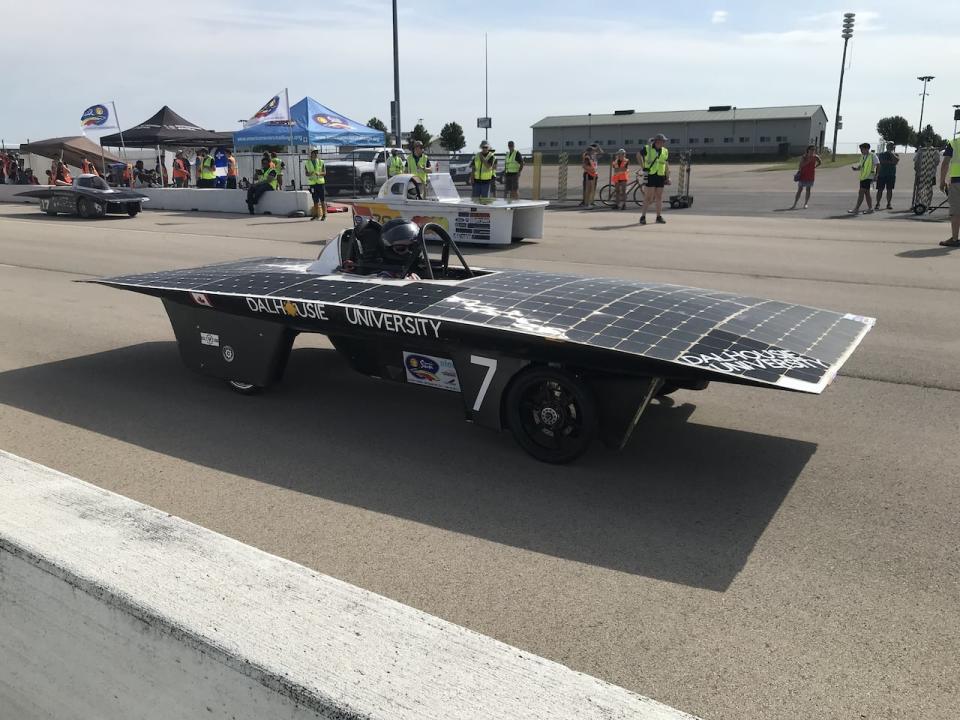Dalhousie's Solar Car Team hitting the tracks this month
Students from Dalhousie University have been busy making technical improvements to Atlantic Canada's first solar-powered electric vehicle in preparation for its second appearance at an international competition this month in Kentucky.
The Dalhousie Solar Car Team will race against 33 other teams from across North America in the Formula Sun Grand Prix, an annual solar car racing competition intended to encourage post-secondary students to design, build and drive innovative solar-powered vehicles.
"Really, our goal is to show the big industry players that if students can make something as efficient and green as this, they can do it as well," said Kate Arsenault, the Dalhousie team's electrical support and fundraising lead.
"We're students, we're doing our own funding for this. They have the funding to do it as well, and they have the expertise."
Teams will be given an eight-hour driving period each day over the span of three days at the closed-course National Corvette Museum Motorsports Park in Bowling Green, testing the limits of each vehicle's brakes, acceleration and turns. The car that completes the most laps wins.
The Dalhousie team was formed in 2021 by student volunteers as a club. Since then, more than 100 students in engineering fields such as mechanical, industrial, environmental, electrical and chemical have worked on the project. Their mission is to promote green energy by encouraging the younger generation through new innovation.

On top of the team's five-foot-long car is a solar array of cells that convert sunlight into electrical power to charge the battery and motor controller found underneath the top of the car.
The challenge is finding the time outside of the classroom to work on the car, Arsenault said. The team recalled spending long nights in the shop last year making adjustments leading up to the race.
"A lot of it is just time management and being dedicated to the team and making sure you're showing up for that, but then also focusing on your studies," she said.
This year, the team seems to be on schedule for the July 16-18 competition, but getting to that point is not a smooth ride.
"Every time we're working on the solar car, you find something new that needs to be fixed or something new that we want to implement," said Joelle Korkomaz, the mechanical support on the team. "Sometimes things break and you have to order a new thing that might take weeks or months to come in."
One of their major goals this year was to redesign the array, but the team ran out of time.
"Things don't always go according to plan, but that's part of the design challenge," Korkomaz said.
Arsenault said classrooms don't offer this type of education.
"By being on a team like this, where it's just all technical and a lot of hands-on, it really gives you the experience to go into the industry and apply those learnings."
The biggest obstacle was the roll bar, a structural frame above the driver's head to offer protection in case of a rollover. The team had to redesign and assemble it from scratch to meet new race requirements.
Seeing the car in action
The car weighs about 270 kilograms and can reach a speed of up to 65 kilometres an hour. In last year's competition in Topeka, Kan., they drove 135 laps or 540 kilometres, team lead Noah Bugden said.
"The main thing is getting to see the car in action," said Bugden. "We spend so much time here in the shop working on it. It's rewarding to see the car move."
Korkomaz said winning isn't the important thing.
"Even if we don't bring home a medal or a prize, I'm still very happy with what we've accomplished. We've worked really hard as a team and we've come a long way."
The car will be transported across the border by a trailer truck.
MORE TOP STORIES


